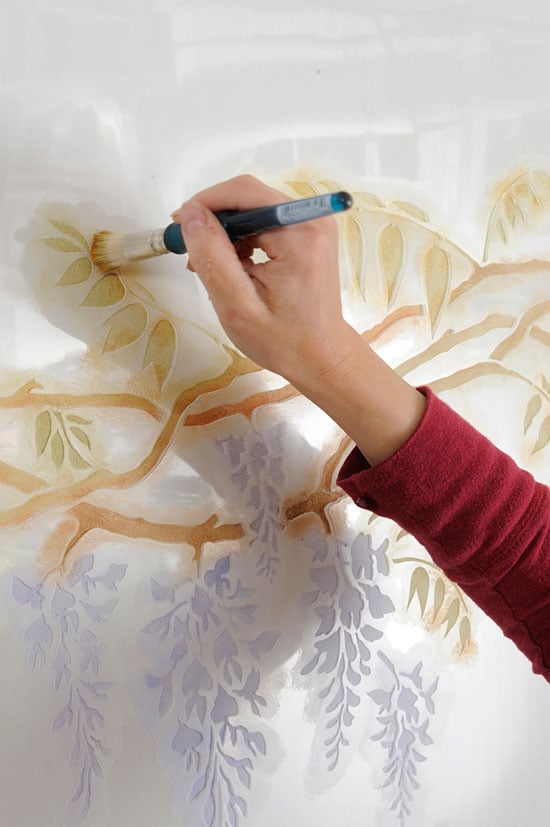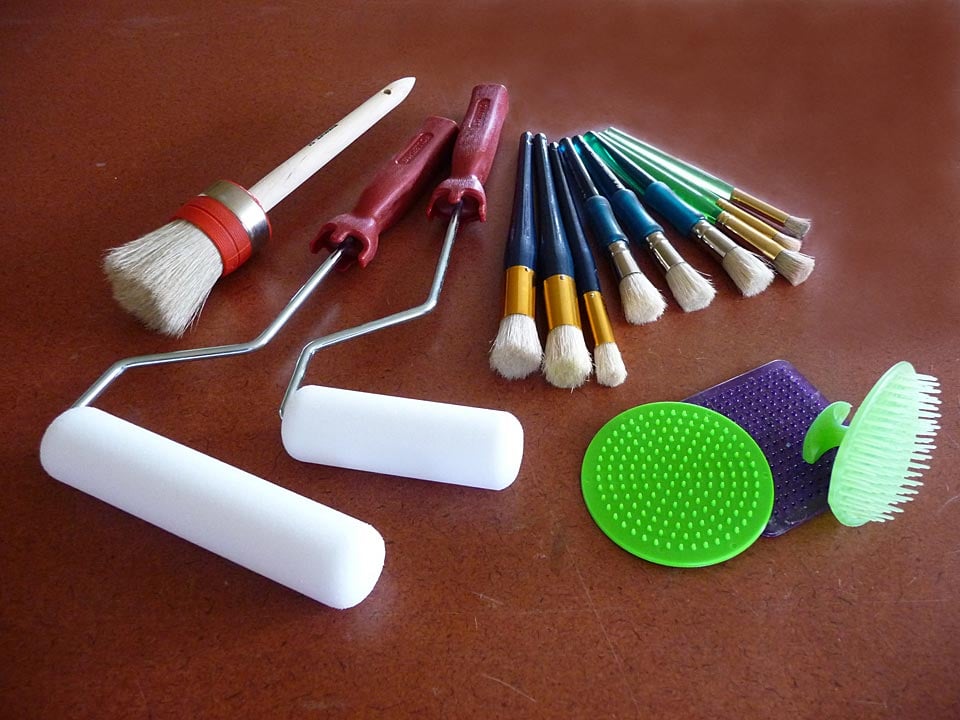Roller stenciling tips: How to stencil with a roller
Stenciling with a dense foam roller is by far the fastest stenciling technique, and also the easiest. However, there are couple things to keep in mind to make sure the results are perfect.
Rule #1: do not overload your roller with paint and always blot off excess paint onto a paper towel.
If you want crisp lines on your stencil print, or if you are using contrasting colors, please use spray adhesive. I personally almost never use it, but for a beginner it might be very helpful. Shake the can well, then lightly mist your stencil with Elmer's (or other craft brands) spray adhesive, let it dry for a few seconds and place the stencil on a wall or whichever surface you're working on. I personally prefer to use the blue painters tape to secure my stencils. With right amount of paint on your roller and right pressure there is usually no bleed at all and edges are crisp. Here I am not using any spray adhesive, just some tape.

Start rolling over the stencil with your loaded foam roller applying light to medium pressure. You'll see that your initial coverage might be a bit light, so keep rolling over the stencil in short back-and-forth strokes until you get your desired coverage. It is much better to start light and quickly build the opaque coverage, rather than press on the roller too hard right from the start and possibly get paint bleed underneath the stencil. You'll very quickly get the feel for just perfect pressure, and your stenciling result will be fabulous.


It's very easy to check how it's going by carefully lifting a corner of the stencil and taking a peek. I always check when I stencil, and I recommend you do too. It's easy to make any adjustments early into the project. Place the stencil back and continue stenciling.

Usually after a couple prints you'll notice that there is not enough paint in your roller anymore. It means it's time to reload your stencil roller with more paint. Avoid the temptation of pressing hard on a roller to squeeze out the last bit the paint! You may get undesirable paint seepage if you use excess pressure.

One more thing: while rolling over the stencil with your roller, pay attention to the edges. It's easy to get carried away and roll over the edge, especially once you see how easy and fast it is. If this happens, simply wipe off the spot with a moist rag or baby wipe. We design our stencils with nice margins around the design to make sure you'll have some rolling room. Also, strategically placing a piece of painters tape at the narrowest edges will help prevent "roll-overs". Just slow down a bit next to the edges and you'll not roll over them.

Removing of the stencil is the most exciting part of the whole process! :) Can you believe I just rolled that with a roller? So much fun. Now let's do it again!

Simply repeat the process for as many stencil prints as you want! No need to clean a stencil in between repeats, unless you're switching colors from dark to light.

So that’s it, a basic stencil rolling technique. Can’t be any easier! It works great for large wall art stencils, for allover patterns such as damask stencils and trellis patterns, and for other various stencil ornaments.

Quick and easy room transformation! Create a vignette or an allover pattern using the same simple stencil roller technique.
Same simple technique is used for this modern Funky Wheel stencil (note how nice and crisp the edges are, and I am not using any adhesive):
Stay tuned for more stenciling tips and tricks!
Janna









